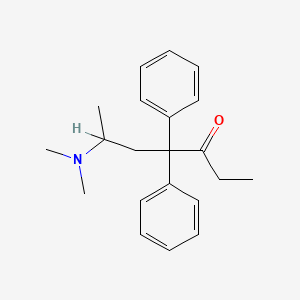Drug Information
Drug (ID: DG00132) and It's Reported Resistant Information
| Name |
Methadone
|
||||
|---|---|---|---|---|---|
| Synonyms |
Adanon; Algovetin; Althose; Amidon; Amidone; Biscuits; Dextromethadone; Diaminon; Dollies; Dolly; Dolophin; Dolophine; Heptadone; Heptanon; Ketalgin; Levometadona; Levomethadonum; Levothyl; Metadona; Metadone; Metasedin; Methadon; Methadona; Methadonum; Methaquaione; Phenadone; Polamidone; Polamivet; Westadone; Dolophine HCL; Levomethadone [INN]; Metadona [Spanish]; Metadone [DCIT]; Methadona [Spanish]; Methadone HCL Intensol; Methadone M; Methadonum [Latin]; Racemic methadone; A 4624; AN 148; Hoechst 10820; K 174; Amidone (TN); D-Methadone; Dl-Methadone; Dolophine (TN); Heptadon (TN); Heptanon (pharmaceutical); L-Methadone; L-Polamidon; L-Polamivet; Levometadona [INN-Spanish]; Levomethadonum [INN-Latin]; Metadona [INN-Spanish]; Methadone (BAN); Methadone [INN:BAN]; Methadonum [INN-Latin]; Methadose (TN); Physeptone (TN); Sedo-Rapide; Symoron (TN); Dolophine (*Hydrochloride*); Fenadone (*Hydrochloride*); Heptadone (*Hydrochloride*); Heptanon (*Hydrochloride*); Hoescht 10820 (*Hydrochloride*); Phenadone (*Hydrochloride*); AN-148 (*Hydrochloride*); L-(+)-Methadone; S-(+)-Methadone; D-6-(Dimethylamino)-4,4-diphenyl-3-heptanone; L-6-(Dimethylamino)-4,4-diphenyl-3-heptanone; (+)-Methadone; (+-)-Methadone; (+/-)-Methadone; (+/-)-Tussal; (-)-(R)-6-(Dimethylamino)-4,4-diphenyl-3-heptanone; (-)-Methadone; (6R)-Methadone; (R)-6-(Dimethylamino)-4,4-diphenyl-3-heptanone; (R)-6-(Dimethylamino)-4,4-diphenyl-3-hetpanone; (S)-6-(Dimethylamino)-4,4-diphenyl-3-heptanone; 3-Hetpanone, 6-(dimethylamino)-4,4-diphenyl-, (R)-(9CI); 6-(Dimethylamino)-4,4-diphenyl-3-heptanone dl-mixture; 6-(dimethylamino)-4,4-diphenylheptan-3-one; 6-Dimethylamino-4,4-diphenyl-3-heptanone; 6-dimethylamino-4,4-di(phenyl)heptan-3-one; 6S-Methadone
Click to Show/Hide
|
||||
| Indication |
In total 1 Indication(s)
|
||||
| Structure |

|
||||
| Target | Opioid receptor (OPR) | NOUNIPROTAC | [1] | ||
| Click to Show/Hide the Molecular Information and External Link(s) of This Drug | |||||
| Formula |
C21H27NO
|
||||
| IsoSMILES |
CCC(=O)C(CC(C)N(C)C)(C1=CC=CC=C1)C2=CC=CC=C2
|
||||
| InChI |
1S/C21H27NO/c1-5-20(23)21(16-17(2)22(3)4,18-12-8-6-9-13-18)19-14-10-7-11-15-19/h6-15,17H,5,16H2,1-4H3
|
||||
| InChIKey |
USSIQXCVUWKGNF-UHFFFAOYSA-N
|
||||
| PubChem CID | |||||
| ChEBI ID | |||||
| TTD Drug ID | |||||
| DrugBank ID | |||||
Type(s) of Resistant Mechanism of This Drug
Drug Resistance Data Categorized by Their Corresponding Diseases
ICD-21: Symptoms/clinical signs/unclassified clinical findings
| Drug Sensitivity Data Categorized by Their Corresponding Mechanisms | ||||
|
|
||||
| Key Molecule: ATP-binding cassette sub-family B5 (ABCB5) | [1] | |||
| Molecule Alteration | Expression | Down-regulation |
||
| Sensitive Disease | Pain [ICD-11: MG30.0] | |||
| Experimental Note | Revealed Based on the Cell Line Data | |||
| Experiment for Molecule Alteration |
ATPase activity assay | |||
| Mechanism Description | P-glycoprotein (Pgp) is a multidrug resistance transporter that limits the penetration of a wide range of neurotherapeutics into the brain including opioids. Pgp-knockout mice had more than a 10-fold higher level of loperamide in their brains than wild-type. Both rats and humans have shown elevated levels of loperamide in the presence of the Pgp-specific inhibitor cyclosporine A. | |||
References
If you find any error in data or bug in web service, please kindly report it to Dr. Sun and Dr. Zhang.
